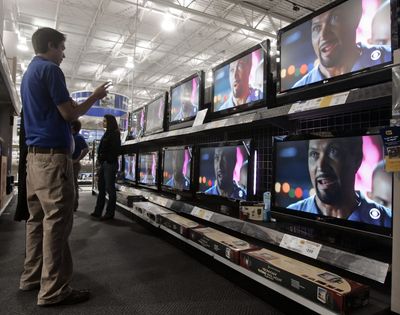Going high-def
How to select the right TV for the Super Bowl and beyond

NEW YORK — If you haven’t yet sprung for a high-definition TV set, the week before the Super Bowl is a good time to make the upgrade. Sports look great in HD, and football in particular is easier to follow on a big, sharp screen.
The bad economy has curbed many people’s appetites for big-ticket purchases, but consider that prices for flat-panel TVs 32 inches and smaller are now very close to what old-fashioned, tube-based TVs used to cost, with some models going for as little as $400. Of course, bigger TVs make for a more compelling viewing experience, but even a smaller HD set is a good step up from a standard-definition set.
Here are some ideas to keep in mind if you decide to go high-def.
•What size screen should I get? A common rule of thumb is this: Take the distance you’ll be sitting from the TV set, in feet. Multiply it by four to get the number of inches of screen diagonal you should get. If you sit 10 feet from the TV, that works out to a 40-inch set. That’s the minimum size — you will certainly appreciate an even larger one.
If you’re choosing between a smaller TV with premium features or a larger TV for the same price, go for the larger one.
•LCD or Plasma? Liquid-crystal displays, or LCDs, have become the default choice for HDTV buyers, with nearly 90 percent of the market. But don’t rule out plasma sets. These can be cheaper for the same size of screen, and yield excellent image quality, with deeper black images than most LCD screens. However, plasma ones are thicker and heavier and use more power than LCD screens. The most noticeable difference is that they have glossy glass surfaces, which can produce annoying reflections from light sources.
Rear-projection sets are still around, accounting for a few percent of the market. Consider these if you want the largest possible screen and don’t mind that they’re not flat, wall-mountable slabs like LCDs and plasma. Image quality can be good, but they’re less bright than flat panels and even dimmer when not viewed straight on.
•When you explore screens that are around 40 inches, you’ll be confronted with another question: 720p or 1080p? This refers to the resolution of the screen, with 1080p being the sharpest. But chances are you won’t notice the difference unless you sit fairly close or the screen is very big. A 720p set is fine for DVDs, which aren’t high-definition. If you plan to get a Blu-ray player or to hook up an Xbox 360 or other video game console to the set, 1080p makes more sense. For LCD screens 40 inches or larger and all rear-projection sets, 1080p is now standard.
•There’s another feature that can have a big effect on the image quality: a 120-hertz “refresh rate,” coupled with image-processing technology variously known as “Motion Flow” and “Smooth Motion.” TV is shot at 30 frames per second, and movies at 24 frames per second. This is fast enough to give us the impression of continuous motion, but not fast enough to make high-action or camera-panning scenes look smooth and steady. High-end TVs now compensate for this by computing extra frames and inserting them between the existing ones. Combined with a screen that refreshes the image 120 times per second, this means smoother football action.
•So how does the set hook up? You’ll want to have as many HDMI (High-Definition Multimedia Interface) inputs as possible. HDMI cables provide the best connection between a TV set and a signal source like a set-top box, DVD player or game console. They’re also simple to connect, with one HDMI cable replacing as many as five video and audio cables. Three inputs have become standard, but some cheaper sets scrimp.
•Lastly, once you have your set, don’t forget to hook it up to a high-definition signal! Some people get an HD set and then think they’re watching HD, when in fact they’re watching blurry old standard-definition programming. The cable or satellite company can walk you through getting an HD signal, but if you’re in a hurry to watch the Super Bowl or don’t have pay TV, connect an antenna and tell the set to scan the airwaves.